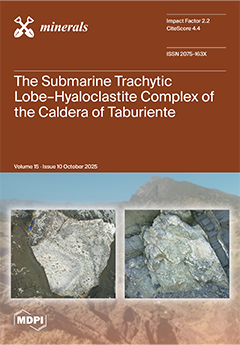The Southern Great Xing’an Range (SGXR), an important W–Sn polymetallic metallogenic belt in northern China, hosts multiphase magmatism and has witnessed recent discoveries of multiple tungsten–tin polymetallic deposits. The W–Sn mineralization in this area is intimately associated with Early Cretaceous highly fractionated granites.
[...] Read more.
The Southern Great Xing’an Range (SGXR), an important W–Sn polymetallic metallogenic belt in northern China, hosts multiphase magmatism and has witnessed recent discoveries of multiple tungsten–tin polymetallic deposits. The W–Sn mineralization in this area is intimately associated with Early Cretaceous highly fractionated granites. The Chamuhan deposit, a small-sized W–Mo polymetallic deposit in SGXR, is genetically linked to a concealed fine-grained porphyritic alkali feldspar granite intrusion. In this study, we present the LA-ICP-MS zircon U-Pb ages, whole-rock geochemical, and electron probe microanalysis (EPMA) mineral chemistry to constrain the petrogenesis and metallogenic implications of this granite. Zircon U–Pb dating yields a crystallization age of 141.3 ± 1.2 Ma, consistent with molybdenite Re–Os ages. The granite is characterized by elevated SiO
2 (76.9–79.1 wt%) and total alkalis (7.3–8.5 wt%), and exhibits peraluminous high-K calc-alkaline affinity (A/CNK = 1.37–1.57). Geochemical signatures reveal enrichment in large ion lithophile elements (LILEs, e.g., Rb, Th, U) coupled with depletion in high-field strength elements (HFSEs, e.g., Ba, Sr, P, Eu, Ti, Nb, Ta), and are accompanied by right-sloping REE patterns with LREE enrichment and HREE depletion. EPMA data indicate that the mica in the intrusion is primarily zinnwaldite and Li-rich phengite, whereas the plagioclase occurs as albite. The feldspar thermobarometry yields crystallization temperatures of 689–778 °C and 313 MPa–454 MPa, while the melt H
2O content and oxygen fugacity are 8.61–11.1 wt% and −22.58–−14.48, respectively. These geochemical signatures indicate that the granites are highly fractionated I-type granites with extensive fractional crystallization of various minerals like plagioclase, K-feldspar, and apatite, etc. From the Late Jurassic to the Early Cretaceous, the subduction and rollback of the Paleo-Pacific Ocean plate resulted in extensional tectonic environments in eastern China. Asthenospheric upwelling and lower crustal melting generated parental magmas, wherein progressive fractional crystallization during ascent concentrated ore-forming elements and volatiles within residual melts. This process played a key role in the formation of the Chamuhan deposit, exemplifying the metallogenic potential of highly evolved granitic systems in the SGXR.
Full article





